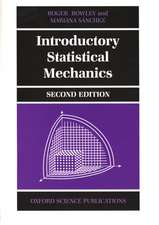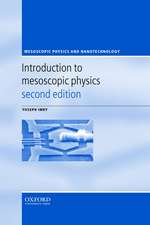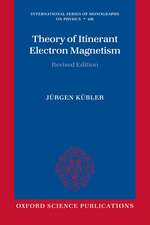Solid · State Magnetism
Autor John Crangleen Limba Engleză Paperback – 7 dec 2012
Preț: 383.71 lei
Nou
Puncte Express: 576
Preț estimativ în valută:
73.43€ • 76.16$ • 61.23£
73.43€ • 76.16$ • 61.23£
Carte tipărită la comandă
Livrare economică 27 martie-10 aprilie
Preluare comenzi: 021 569.72.76
Specificații
ISBN-13: 9781461367482
ISBN-10: 1461367484
Pagini: 220
Ilustrații: XII, 206 p.
Dimensiuni: 155 x 235 x 12 mm
Greutate: 0.31 kg
Ediția:Softcover reprint of the original 1st ed. 1991
Editura: Springer Us
Colecția Springer
Locul publicării:New York, NY, United States
ISBN-10: 1461367484
Pagini: 220
Ilustrații: XII, 206 p.
Dimensiuni: 155 x 235 x 12 mm
Greutate: 0.31 kg
Ediția:Softcover reprint of the original 1st ed. 1991
Editura: Springer Us
Colecția Springer
Locul publicării:New York, NY, United States
Public țintă
ResearchCuprins
1 Introduction.- 1.1 Basic magnetic properties.- 1.2 Units in magnetism.- 2 Localized magnetism associated with the ion cores.- 2.1 The origins of the magnetic properties of materials.- 2.2 The magnetic moment of a single free ion.- 2.3 The magnetic moment of an assembly of atoms, without interactions.- 2.4 Paramagnetic susceptibility of an array of atoms.- 2.5 Comparison with experiment.- 2.6 Ferromagnetism in the local moment model, with interactions.- 3 Magnetism associated with band electrons.- 3.1 Collective electron theory: general solution.- 3.2 Paramagnetism without interactions.- 3.3 Paramagnetism with interactions.- 3.4 Ferromagnetism in the band model.- 3.5 Magnetic moments of pure metals and alloys.- 4 Techniques of making magnetic measurements.- 4.1 Measurement of magnetization.- 4.2 Measurement of paramagnetic susceptibility.- 4.3 Dipole moment methods — SQUIDS.- 4.4 Derivation of spontaneous magnetization from experimental data.- 4.5 The generation of magnetic fields.- 4.6 The measurement of magnetic field.- 5 Magnetic scattering of neutrons and magnetic excitations.- 5.1 Properties of the neutron.- 5.2 Sources of neutrons.- 5.3 Powder diffraction.- 5.4 Inelastic neutron scattering.- 5.5 The polarization of neutron beams.- 5.6 Engineering applications of neutron scattering.- 5.7 Magnetic excitations and spin waves.- 5.8 Brillouin zones in metals.- 5.9 Spin wave resonance.- 6 Antiferromagnetism, ferrimagnetism and non-collinear magnetic order.- 6.1 Antiferromagnetism.- 6.2 Ferrimagnetism.- 6.3 Helimagnetism.- 6.4 The rare earth metals.- 6.5 Spin glasses.- 6.6 Magnetic amorphous alloys.- 6.7 High-TC superconducting ceramics.- 7 Exchange interactions in magnetism and hyperfine fields.- 7.1 Exchange interactions in magnetism.- 7.2 Hyperfine interactions inmagnetic materials.- 8 Domain magnetism.- 8.1 Basic principles.- 8.2 Arrangements of domains.- 8.3 Single domain particles.- 8.4 Soft magnetic materials.- 8.5 Hard magnetic materials.- 8.6 Thin magnetic films and whiskers.- 8.7 Magnetic bubbles.- 9 Applications of magnetism.- 9.1 Permanent magnets.- 9.2 Applications of soft magnetic materials.- 9.3 Magnetic tape recording.- 9.4 Applications of magnetic bubbles.- 9.5 Imaging by nuclear magnetic resonance.- 9.6 Magnetic phase analysis of alloys.



















